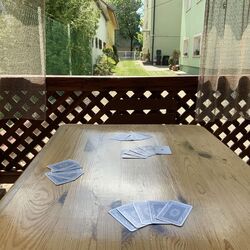A treat for all your senses
You might not expect a magical chocolate experience among the rolling hills of Zala near Lake Balaton — but it’s true!
At KakasBonbon in Felsőpáhok, every bonbon transports you to distant lands while celebrating local flavors. The chocolate shell gently cracks, the filling melts in your mouth. Everything you need for an unforgettable tasting.
The story of the weathercock & chocolate
The story of KakasBonbon began over 15 years ago when János Szabó and Andrea Tésenyi left their old lives behind and found a new calling in chocolate-making. The iconic weathercock originally perched atop a farmhouse in Máriagyűd, now serves as their symbol and guide in the world of chocolate. The family’s journey took them from Máriagyűd to Sopron, and finally to Felsőpáhok — much to the delight of locals and visitors alike.
Today, their workshop and “bonbon apothecary” welcome chocolate lovers from near and far.
A special gift for pairing flavors
Andrea is the creative force behind the chocolates. Beyond mastering the craft, she possesses a refined sense for pairing flavors and designing memorable forms. For her, making bonbons is less a job and more a form of meditation.
Prunes, pumpkin seed & apple, yuzu — and more
KakasBonbon offers over 70 flavors, though not all are available year-round. The selection changes with the seasons, ensuring every bonbon is fresh and its aromas at their peak. In harvest season, grape flavors take the spotlight. Winter brings rich cocoa creations, while summer features citrus and berries.
Andrea also crafts milk and dark chocolate bars, hot chocolate bombs, and festive shapes for special occasions. All chocolates share the same pure foundation: select single-origin cacao beans, cream (or a lactose-free alternative), and natural fruit or spice essences. The cacao is sourced from diverse regions — Italy, France, Spain, Vietnam, South America — while the fillings highlight local ingredients. Their recipes are clean and simple, as are their elegant decorations.
Visit the weathercock in Felsőpáhok!
At their Felsőpáhok home, you’ll find a shop, workshop, terrace, and cellar — a perfect setting to taste their creations and meet the makers.
You can also join Bor & Bonbon events, where chocolates are paired with carefully selected wines, creating either a delightful evening or an extraordinary journey of flavors.
Product highlights
Hazelnut KakasBonbon Chocolate Bar
This artisan chocolate bar features roasted hazelnuts from Cserszegtomaji Finomságok — carefully selected and small-batch roasted for an authentic, rich flavor. Andrea hand-tempers single-origin chocolate and pours it into molds with practiced precision. Thanks to its high cacao content, this bar is not only delicious but also beneficial for your health, rich in flavonoids and antioxidants. In this chocolate bar, two worlds meet in perfect harmony: locally grown hazelnuts from the Zala hills and premium cacao beans sourced from thousands of kilometers away.
Where to buy
- 8395 Felsőpáhok, Dózsa Street 3
- Google Maps
More Information & Contact:
Imagine a vast body of water — over 1,000 meters deep and more than 400 times the size of Lake Balaton — once rippling across this land. The story of the Pannonian Lake is not just a fascinating chapter of geological history, but a legacy that continues to shape the region: it left behind mineral resources, fertile soils, and even inspired legends. Discover how an ancient lake transformed Transdanubia — and why its impact is still felt today. An Inland Sea for Millions of Years At its greatest extent, the Pannonian Lake covered an enormous area, far surpassing the size of today’s Balaton. For millions of years (approximately 12 to 8.5 million years ago), it dominated the region. As surrounding mountain ranges gradually rose, the lake became cut off from the world’s oceans. Its water slowly turned fresh, and its basin began to fill with sediments. Because of its isolation, the lake developed a unique ecosystem with many endemic species. The Lake Didn’t Appear Overnight The Pannonian Lake didn’t simply “appear” in the Carpathian Basin. Its formation was the result of millions of years of tectonic activity and shifting climate. It emerged as an independent, enclosed body of water — no longer connected to the open seas. Deep Waters, Varied Shores In some areas, the lake reached depths of over 1,000 meters. Elsewhere, shallower zones supported lagoons, river deltas, and small, isolated lakes. During high water periods, rocky shorelines formed along the mountain fringes — traces of which can still be found today in the Keszthely Hills and the Mecsek Mountains. The Lake’s Retreat — and Sediment Legacy Despite its size, the lake was eventually filled in by immense volumes of sediment, carried mainly by rivers flowing from the Alps and the Carpathians. Over the course of 6.5 million years, it gradually disappeared from the landscape. What did it leave behind? Its sediments — composed mostly of sand, clay, and fine silt — became the so-called “Pannonian formations,” which today hold key mineral resources (such as petroleum) and aquifers. These formations define much of the surface geology of Transdanubia, including the Zala Hills. Fertile soils later formed on the laminated silty and clay-rich deposits of the Somló Formation. Even the legendary “Tihany goat’s hoof” fossils — actually worn shell fragments of the Congeria ungulacaprae mollusk — can still be found embedded in these ancient layers. The Final Lakes and a Gradual Goodbye Because most of the sediment entered from the northwest, north, and northeast, the lake slowly retreated toward the south and southeast — as if it were “withdrawing” from what is now Hungary. Small remnant lakes persisted for much longer in areas of present-day Slavonia (Croatia) and northern Serbia, but due to their different scale, character, and fauna, they are not considered true successors of the ancient Pannonian Lake.














